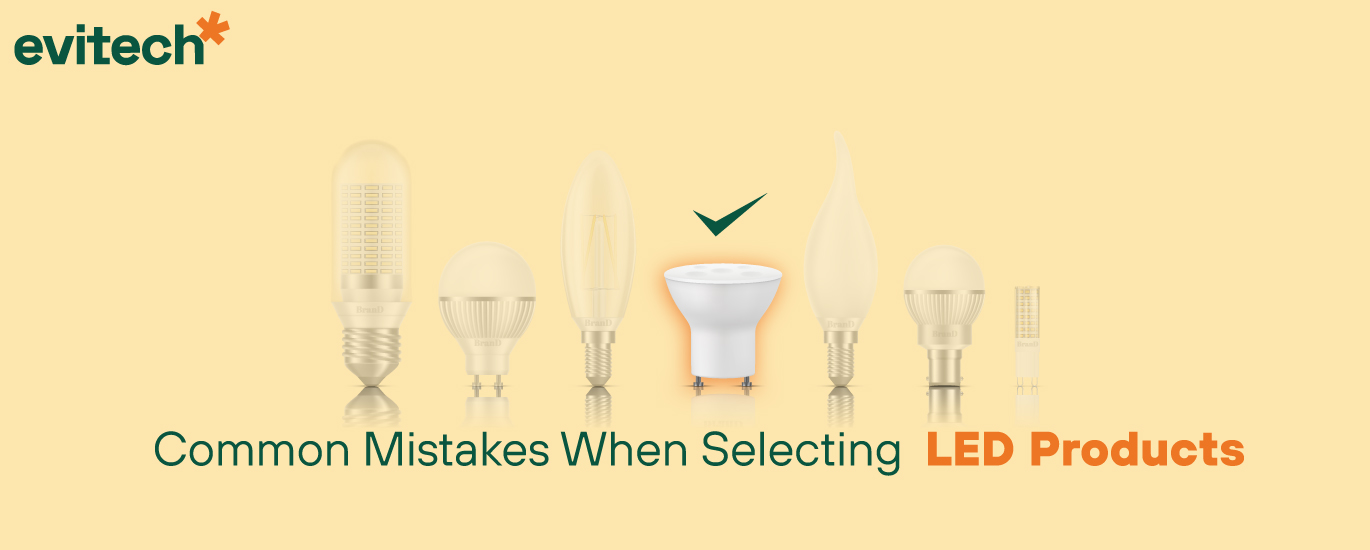Common Mistakes When Selecting LED Products
With proper lighting design, LED products offer significant energy savings, lower maintenance costs, and reduce the need for cooling in air-conditioned spaces. They also offer advantages in security and automation compared to other types of lighting.
However, various technical aspects must be considered when selecting LED products for a lighting system. This article summarizes some of the most common mistakes, with recommendations to avoid them in your building.
LED lighting Using Wrong Color LED Products
Not all shades of white light are the same: there are warm-yellow tones with a colour temperature (CCT) of less than 3000K, neutral whites of 4100K and shades with a blue tint of up to 6500K. Each shade is suitable for different applications:
Warm tones create a relaxing atmosphere and are recommended in hotels, restaurants, and the like. Its relaxing effect can be counterproductive in offices or industrial premises.
- Cool tones increase concentration and attention to detail. They are generally worn outdoors or where high-precision tasks are performed, but it can be difficult to fall asleep when these shades are worn in a bedroom.
- Neutral tones offer balance. They are suitable where care is required for extended periods, as cool tones can be stressful in the long run. Kitchens, offices and classrooms are some ideal spaces for neutral white light.
In lighting designs, it is very important to use LED products with the light of the right colour since a poor selection can negatively influence the productivity and well-being of users.
It is worth mentioning that there is a subjective factor of personal preference, and a user can opt for an unconventional light tone. However, the above recommendations are by best lighting practices.
Lighting Too Low or Excessive
With incandescent lighting used for decades, it was common to compare the brightness of light bulbs based on the wattage rating. This was possible since all the bulbs used the same design, and there was a correlation between wattage and brightness.
However, this principle does not apply when comparing LED products to older lighting systems since LEDs produce more light for each watt consumed. For example, a 100-watt LED fixture is up to six times brighter than a 100-watt incandescent bulb.
LED lighting should be specified based on the amount of light produced, measured in lumens. Consider that a 100-watt incandescent bulb produces about 1,600 lumens, and the 1,600-lumen LED bulb that replaces it consumes only about 16 watts. A 100-watt LED bulb produces more than 10,000 lumens, which is overkill in this case.
An LED lamp must produce light of the right colour and in the right amount, depending on the application.
Incompatibility Between Lamps and Luminaires
It is important to understand the difference between lamps and luminaires. The lamp is the specific device that produces light, while the luminaire is the complete assembly that includes the base where the lamp is connected, the housing, and all additional circuits and connections.
There are many cases when using LED products in existing installations where only the lamp is replaced, not the entire assembly. The idea is to decrease the total cost of implementing LED lighting.
However, there are two important things to check:
· The replacement LED lamp must be compatible with the socket base.
· The ballast, if any, must also be compatible.
This confusion is common when replacing T8 fluorescent tubes with LED tubes. Some LED tubes are compatible with T8 ballasts, while others need to be connected directly to the AC power source.
In other cases, the LED tubes are connected to a driver, similar to a ballast, but exclusively for LEDs.
Incompatibility between systems can have serious consequences. At best, the LED lamps won’t turn on; in the worst-case scenario, both the lamp and the luminaire can be permanently damaged, and there is a risk of fire.
Conclusion
LED lighting is a great technology, but it requires the proper installation to deliver its benefits. A poorly designed LED system brings additional maintenance costs and can result in inadequate lighting.
A professional opinion is recommended before proceeding with any LED lighting project to achieve the best results.
Latest Post
- Why do LED Spotlights Burn?
- What is the electricity consumption of LED Christmas lights?
- What are LED lighting towers, and What are their Applications?
- Using Natural Light in LED Lighting Designs
- Use of LED Lights in Domestic Houses
- Three Ways to Apply LED Light in Buildings
- Savings in Air Conditioning with LED Lighting
- Replacement of Halogen Spotlights by LED
- Recommendations when Buying LED Lights for Cars
- LED Lighting Connected to the Internet: A Promising Technology


